Canon PowerShot A1200
-
-
Written by Gordon Laing
Intro
Announced in January 2011, the Canon PowerShot A1200 is a 12.1 Megapixel budget compact with a 4x optical zoom lens and 2.7 inch LCD screen. Unusually for a compact camera these days, the A1200 is also equipped with a small optical viewfinder. In another slight departure from convention it additionally relies on two AA batteries for power rather than a proprietary Lithium Ion battery.
The PowerShot A1200 has all of the ease-of-use features you’d expect from a budget compact – only the PowerShot A800 sits below it in the A-series line-up – and also includes new features like Live View Control and Creative filters. Impressively for the money, it can also shoot 720p HD video, but like the A800 below it, lacks any form of image stabilisation.
The PowerShot A1200 has a lot to offer for a budget camera and is only a little more expensive than Canon’s entry level A-series PowerShot, the A800, so is the PowerShot A1200 worth the extra cash, or are you just paying for features you’re unlikely to make much use of? To find out, we tested the two PowerShots side-by side, along with seeing how Nikon’s COOLPIX L24 compares. The L24 is Nikon’s budget compact for 2011, replacing the COOLPIX L22. Nikon has gone for more resolution increasing the count from 12 to 14 Megapixels. That’s great news if you want to make big prints on a small budget, but how does the L24 shape up against the PowerShots in terms of other features? Read our full review to find out which of these budget compacts best fits your needs.
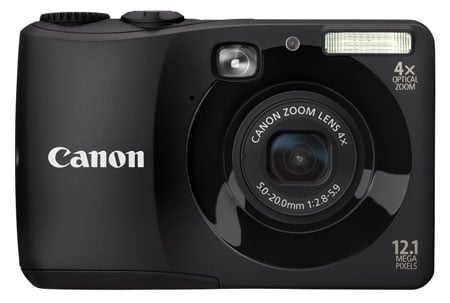 |
Canon PowerShot A1200 design and build quality
The Canon PowerShot A1200 is available in either silver or black; we reviewed the matt black model which looks stylish as well as being comfortable to hold in the hand. Unlike the wedge-shaped styling of the PowerShot A800, the A1200 opts for a bulging right side to accommodate the two AA batteries. A defined edge to the bulge provides a good purchase for your fingers and, though this isn’t one of Canon’s smallest PowerShots, it’s nicely proportioned. Launched simultaneously, the PowerShot A2200, a 14.1 Megapixel model with a lithium Ion battery, but otherwise similarly specified, is the slimmest A-Series model to date.
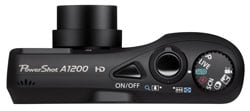 |
Unlike the less expensive A800, the PowerShot A1200 has a mode dial, located on, but not extending over the edge of, the top panel. Its position means you need to use both your thumb and forefinger to move it, but it isn’t difficult to operate and there’s no danger of shifting it accidentally, say when you slip the camera into our out of your pocket.
There are eight positions on the mode dial – Program auto, Live Control View, (Smart) Auto, Easy, SCN, Creative Filters, Discrete mode and, Movie mode. Alongside the mode dial is a large, slightly protruding shutter button with a zoom collar surround and a flush-mounted triangular shaped on/off switch.
The top panel transitions into the back via a 45 degree bevelled edge on which is mounted the optical viewfinder. Optical viewfinders have all but disappeared from compacts and it’s great to see one reintroduced on the A-series. The optical viewfinder provides an alternative to the screen in bright sunlight as well as a means to extend battery life – you can turn off the PowerShot A1200’s screen and use the optical viewfinder exclusively. The viewfinder is bright, but not especially large, or, to put it another way, it’s tiny, but despite its small size it’s a real asset.
Below the viewfinder is the 2.7 inch LCD screen and to its right the control panel. The four-way control pad in the centre is used to navigate menus as well as providing single-touch access to exposure compensation, flash, self-timer and macro focussing. The Func.Set button in the middle OK’s menu selections but has a more important use activating the shortcut Function menu containing frequently used settings.
Underneath the control pad the menus proper are activated by a menu button next to which is another button for toggling screen display overlays; this button can also turn the screen of if you want to use the viewfinder and conserve battery power. Above the control pad are a further two buttons one to enter playback mode and another that selects the main subject in Face AiAF focusing mode.
A fairly large soft cover on the right side of the camera body opens to reveal a USB port for transferring photos and videos to your PC, a DC in port and an AV port for connecting the camera to your TV. Only a USB cable is supplied, so if you want to power the camera from the mains or connect it to your TV, you’ll need to pay a little extra for the optional cables.
On the bottom of the camera behind a securely locked door – you need to slide a catch across, then slide the door outwards to open it – is the battery and memory card compartment. The PowerShot A1200 takes SD (HC, XC) cards.
The PowerShot A1200 has a built-in flash unit with a quoted range of 4 metres at the wide angle lens setting. The absence of an ISO setting to which this figure relates makes it useless for comparison purposes but in practice the PowerShot A1200 produced even lighting that adequately illuminated indoor subjects within the quoted range. If the integral flash isn’t adequate Canon recommends the optional HF-DC1 external flash unit. This has a bracket which can be attached to the PowerShot A1200 or you can use it off the camera. It has a built-in sensor and acts as a slave unit when the A1200’s integral flash is fired.
Previous AA-powered PowerShots we’ve tested have been slow to recycle the flash, but the PowerShot A1200 is comparatively swift, taking a mere four seconds to charge the flash ready for another shot. The flash has four modes, Auto, On, Slow Synchro and off. Smart flash exposure and Face detection flash exposure automatically adjust the flash to correctly expose subjects closer to the camera.
As we’ve said, the PowerShot A1200 relies on AA batteries for power, and two alkaline AA’s are included in the box. The advantage of AA’s is that you can easily replace them if they run out, say, while you’re on holiday. With a proprietary Lithium Ion battery of the kind used in most compacts, unless you have the charger with you, you’re out of luck. That said, many people prefer the convenience of a single battery/charger.
With the Alkaline AAs you’ll get 200 shots before the power runs out, which is on the low side comparatively speaking. Switch to NiMH rechargeables, though, and you can expect the batteries to last for 450 shots. If you turn off the LCD screen and rely on the optical viewfinder to compose shots those figures increase to a whopping 650 and 1100 shots respectively. All of these numbers are achieved using the Camera Imaging Products Association’s (CIPA) standard testing procedures.
Canon PowerShot A800 lens and stabilisation
The PowerShot A1200’s 4x optical zoom lens has a range of 5 – 20mm, or 28 – 112mm equivalent. Budget compacts typically have optical zooms with a range around 3.5 to 4x and at the telephoto end there’s not a lot to differentiate them. A maximum zoom of, say 134mm on the Nikon COOLPIX L24 will get you a little closer to the action than the PowerShot A1200’s 112mm, but neither is going to get you close enough to distant action to tightly frame shots. In both cases you’re going to have to use your feet and rely on the zoom to take you that little bit closer then frame up the shot using the zoom.
Canon PowerShot A1200 coverage wide |
Canon PowerShot A1200 coverage tele | |
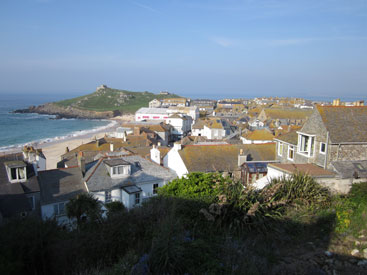 | 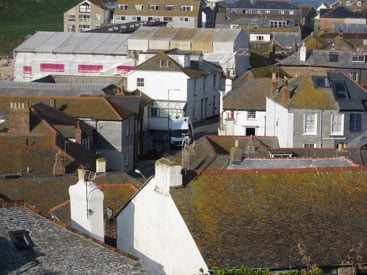 | |
| 5-20mm mm at 5mm (28mm equivalent) | 5-20mm mm at 20mm (112mm equivalent) |
It’s a different story at the wide-angle end of the zoom range though. The PowerShot A1200’s 28mm wide angle gives it a very tangible advantage over the Nikon COOLPIX L24 and the Canon PowerShot A800 with their 37mm maximum wide-angles, allowing you to comfortably accommodate cramped interiors, large groups and panoramic landscapes and get close in for dramatic perspective. If these kinds of subjects are your bread and butter though, you should also take a serious look at the Sony Cyber-shot W510 with its even wider 26mm lens and Sweep panorama feature.
It takes a little over two seconds for the lens to extend and the camera to be ready to shoot. The lens barrel extends in two sections by around 15mm, the motor, which also powers the zoom has a very audible buzz. It’s fast though, zooming the lens through its full range in a little over one second. By nudging the rocker you can jog the zoom through seven discrete steps which is plenty for a 4x zoom.
>
Canon PowerShot A1200 Smart Auto mode / Blur Reduction scene mode | ||||
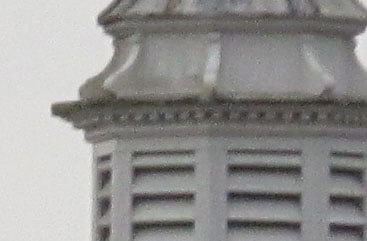 |  | |||
100% crop, 5-20mm at 20mm, 1/30, 400 ISO, Program mode. |
100% crop, 5-20mm at 20mm, 1/250, 3200 ISO, Blur Reduction mode (1600 x 1200). | |||
Like the PowerShot A800, the A1200 lacks Canon’s optical image stabilisation (IS) system. As an alternative it includes a Blur reduction scene mode which produces images at 2M (1200 x 1600) resolution.
The Blur Reduction scene mode detects motion in the frame and sets an appropriately high ISO sensitivity to allow a shutter speed fast enough to eliminate movement. While it’s no substitute for real image stabilisation and merely automatically chooses the best settings for a given situation, it’s a useful additional scene mode for those who want good results in low light without having to think too hard about it. However neither this, nor the Electronic Vibration Reduction post processing on the Nikon COOLPIX L24, are nearly as effective as physical systems. So if image stabilisation is important to you a better budget choice might be the Sony Cyber-shot W510.
The crops above are taken from two images shot with the PowerShot A1200. For both images the lens was zoomed to its full 112mm (equivalent) extent. The crop on the left was shot in Program mode where the A1200 selected an exposure of 1/30 of a second at the manually selected sensitivity of 400 ISO. The crop on the right was shot using the Blur Reduction scene mode which selected a sensitivity of 3200 ISO and a shutter speed of 1/250. For inexperienced photographers the Blur Reduction scene mode could make the difference between getting a usable low light shot and not. But if you’re prepared take things into your own hands you can, in this situation at least, get a much better, full resolution result in Program mode.
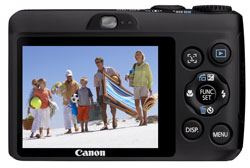 |
Canon PowerShot A1200 screen and menus
The PowerShot A1200 has a 2.7 inch LCD screen with 230 thousand pixels. It’s bright and contrasty and with twice as many pixels as the PowerShot A800 doesn’t suffer from the same pixellated view, though of course the screen quality bears no relation to the camera’s image quality.
The screen is flush mounted and has a glossy plastic surface, so picks up smears and smudges pretty easily, but is also easy to wipe clean. At 3 inches diagonally, the Nikon COOLPIX L24’s screen is slightly bigger, slightly brighter and generally better than the PowerShot A1200’s. The COOLPIX L24’s screen is recessed and has a matt surface that’s less prone to fingerprints. Screens on the PowerShot A1200, A800 and the Nikon COOLPIX L24 all suffered from poor viewing angles though with a marked drop-off in illumination when turned from straight-on.
Like most Canon compacts, the PowerShot A1200’s menus are split between a quick-access Func menu with frequently used settings and a tabbed menu screen that provides access to everything else.
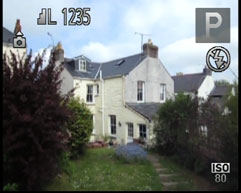 |
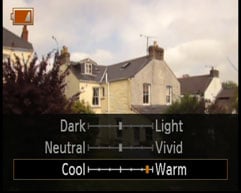 |
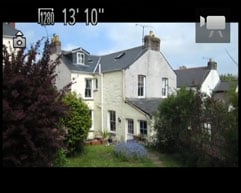 |
The Func menu content is modal. In Program mode it shows ISO sensitivity, white balance, My colours, drive mode, metering mode, image size and quality settings. In scene mode you get to choose the scene mode, plus whatever options the selected scene mode offers. In Live View Control mode adjustment sliders are displayed and in movie mode you can select the movie resolution, set white balance, choose my colours and apply a miniature (tilt-shift) effect. In Easy auto mode the Func menu, along with most other buttons, is disabled.
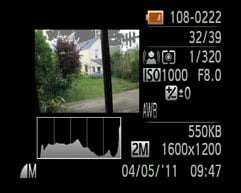 |
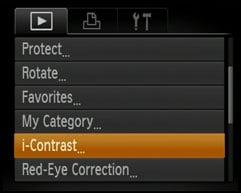 |
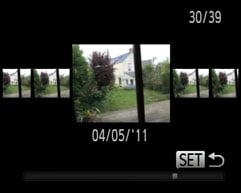 |
The menus are divided on to two tabs – Shooting settings and Camera settings. The Shooting settings tab contains AF mode, digital zoom, Flash (red-eye) settings, blink detection and display overlay – you can overlay a 3 x 3 grid, a 3:2 aspect ratio or both on the screen as a compositional aid. This menu also allows you to enable Canon’s i-Contrast dynamic range enhancement.
The Camera settings menu holds more obscure settings that you’ll most likely change once, then forget about. Here you’ll find LCD brightness, Start-up image choices, card formatting, power saving and date and time settings. You even get to chose alternative shutter sounds – the second option is quieter and less intrusive than the default, though if sounds are a problem you can mute them, or select the new Discrete mode.
Canon PowerShot A1200 exposure modes
The PowerShot A1200 has a much wider range of exposure modes than it’s lower-priced sibling the A800, or for that matter Nikon’s COOLPIX L24. What’s more, there’s a physical mode dial which you can use to select them. If you’re unlikely to venture out of Auto mode, this may be no big deal, but if you like to experiment with exposure it’s much quicker and simpler to flick the mode dial than it is to press the PowerShot A800’s mode button then make a screen selection. And in the absence of a dedicated movie shooting button, being able to switch from still to movie capture at the turn of a dial is a big plus. The fact that the dial rotates through 360 degrees makes it possible to go from Program to Movie mode in a single click.
In addition to the PowerShot A800’s Program, Auto, Scene and movie modes, the A1200 has Live View Control, Easy Auto, Creative filters, and Discrete mode. In auto mode, the PowerShot A1200’s Digic 4 processor provides sophisticated scene detection that can identify the scene type and set the exposure accordingly. As well as differentiating between scenes with and without people (or, as the manual intriguingly puts it, between human and non-human subjects), the Digic 4 can differentiate between day and night, backlighting, spotlighting, blue skies and sunsets and can tell whether your subject is stationery or on the move.
Live View Control, introduced on the top-of-the-range PowerShot A3300, provides results-based controls with direct feedback on the screen. Pressing the Func.Set button displays on screen sliders for exposure compensation, saturation and white balance – except they’re not called that, but simply labelled Dark/Light, Neural/Vivid and Cool/Warm. Using the control pad to select and adjust the sliders provides immediate visual feedback on the screen. You can, of course, achieve the same results in Program mode, but this approach is easier, more direct and intuitive.
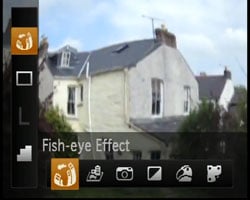 |
Creative Filters mode provides six in-camera special effects which are displayed live on the screen. The six effects are Fish-eye, Miniature, Toy Camera, Monochrome, Super Vivid and Poster. On the right is an example of how the options line up on screen on the PowerShot A1200. For examples of all the creative filters in action see our Canon PowerShot A3300 IS review.
The SCN position provides menu access to 11 screen modes, many of these – Portrait, Landscape, Kids and pets, Snow and Fireworks, will be familiar to users of Canon and other compacts. If you like to shoot at night there’s a Long exposure scene mode that sets the aperture wide open and lets you select an exposure up to 15 seconds long. The low light mode, which sets the exposure between 1600 and 6400 ISO was upgraded from 2 to 4 Megapixel resolution on the PowerShot A3300 IS, but remains at 2 Megapixels on the A1200.
The PowerShot A1200 also has Smart shutter scene mode which automatically takes a series of up to 10 shots when a smile is detected. The smile threshold on the PowerShot A1200 is pretty low, the merest glimmer of a smile being enough to activate it. Additionally, Smart shutter offers wink and face self timer modes, each of which can be configured to take up to 10 shots when you wink or when a new face enters the frame.
Canon PowerShot A1200 focusing and face detection
The PowerShot A1200 has nine-area Face AiAF auto focusing, which is the default focus mode in most exposure modes and is numerically superior to the A800’s five-area system. While we found the PowerShot A800’s Face auto focusing perfectly adequate, the additional AF areas on the A1200 provide an advantage when there are subjects closer to the edges of the frame.
The Digic 4 processor’s Face AiAF makes an excellent job of quickly identifying faces in the frame and locking focus on them. A white frame appears on the main subject and you can choose a different main subject using the Face Select button on the rear panel.
For shots that don’t include people the A1200 defaults to nine-area AF which, like face detection, is fast and decisive and even in low light works pretty well. If the nine-area AF isn’t up to the task, or you just want more control over focusing, there’s a centre focusing option with two sizes of central area. It’s easy to overlook this AF option but, in combination with Focus lock (keeping the shutter button pressed half way) and AF lock (pressing the right button on the control disc), it provides the most control you can get short of full manual focus. There’s one last focus mode, tracking AF, which locks focus on whatever is in the central target when you half press the shutter release and sticks to it wherever it goes.
Canon PowerShot A1200 movie mode
The PowerShot A1200 can shoot HD video at 1280 x 720 resolution (720p). That’s right, HD quality video on a budget compact. You won’t find many affordable point-and-shooters that can make that claim, indeed the best that most, including the PowerShot A800, Nikon COOLPIX L24 and Sony Cyber-shot W510, are able to offer is 640 x 480 pixels. This makes the PowerShot 1200 an obvious choice for those looking for HD video on a budget, albiet not the only choice, as there’s also the Panasonic Lumix S1.
720p HD video is recorded at 24fps, encoded using the H.264 codec and saved in a QuickTime wrapper, in other words as a MOV file. The longest you’ll be able to shoot continuously for is ten minutes, which will give you a file around 1.5GB in size. Standard resolution video can also be recorded at 640 x 480 and 320 x 240 sizes at 30fps also encoded using the H.264 codec and saved as a .mov file. At the 640 x 480 VGA resolution you’ll get a lot more footage on a card – around 50 minutes on a 4GB card compared with about 26 minutes of HD footage.
While you can’t use Creative Filters in the movie mode the A1200 does offer a Miniature effect movie mode that blurs the top and bottom of the frame and shoots at slow frame rates to speed up the action at normal playback speeds. There are three speed options – 5x, 10x and 20x, so filming for 60 seconds at each would deliver playback times of 12, 6 and 3 seconds respectively.
You can’t use the optical zoom while recording on most Canon compacts, so we wouldn’t expect it on a budget model. You can use the 4x digital zoom though, if you’re prepared to accept the dreadful pixellation that results.
| |
|---|---|
|
The PowerShot A1200 is one of the very few budget compacts with 720p HD video. It’s in a different class to the VGA resolution recording offered by most budget models, but you still have to try hard to hold it steady.
| |
|---|---|
|
Things are much smoother with the camera mounted on a tripod. The digital zoom results in such a drop in quality it’s probably best ignored, although you can, of course, use the optical zoom to frame your shot before shooting. The mic has done a great job picking up the birdsong on this clip.
| |
|---|---|
|
The PowerShot A1200 copes quite well in this low light interior panning shot, responding rapidly to the changing light conditions and maintaining good white balance, despite the changing illumination.
Canon PowerShot A1200 drive modes
The PowerShot A1200 has a quoted continuous shooting speed of 1fps and in our test sustained a constant rate a fraction below that. The screen doesn’t go blank between shots, but there’s a lag and you see the previous shot appear on the screen a second after you’ve shot it. That, and the slow frame rate makes it almost almost impossible to properly shoot any kind of action sequence – you just have to point the camera roughly in the right direction and hope for the best. Having said that, the A1200 fares little worse than other budget compacts in this respect, though Panasonic’s low resolution burst modes provide a bit more scope. On that subject, if you switch the A1200 to Blur Reduction or Low light mode, the frame rate increases to nearly 4 fps, albeit at 2M resolution and high ISO sensitivities.
Canon PowerShot A1200 sensor
The PowerShot A1200’s 12.1 Megapixel sensor produces images with a maximum size of 4000 x 3000 pixels at one of two compression settings, Normal and Fine. At the better quality fine setting image size is around 3MB. The ISO sensitivity ranges from 80 to 1600 with up to 6400 ISO automatically selected in Low Light Scene mode.
To see how the quality of the PowerShot A1200 measures-up in practice, take a look at our real-life resolution and high ISO noise results pages, browse the sample images gallery, or skip to the chase and head straight for our verdict.




